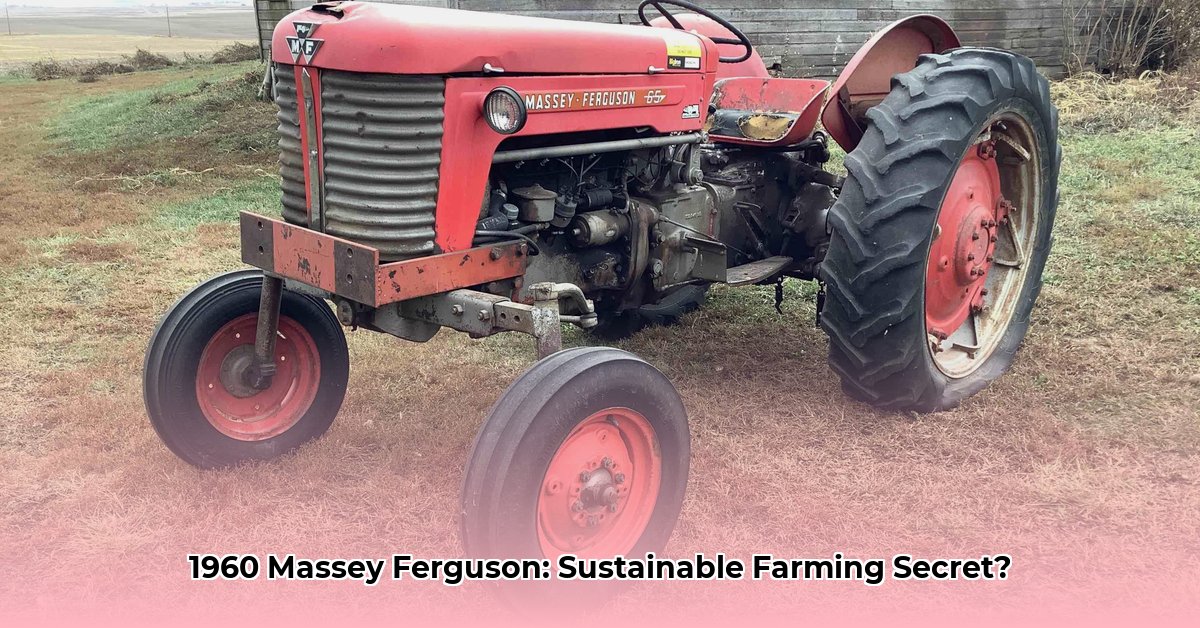
1960 Massey Ferguson 35: A Sustainable Farming Icon
The Massey Ferguson 35, a stalwart of the 1960s, isn't just a relic of the past; it’s a compelling example of sustainable farming practices surprisingly relevant today. This detailed look at the MF 35 will explore its design, performance, and its surprisingly modern implications for environmentally conscious agriculture. We'll compare it to modern tractors, delve into its unique advantages for small farms, and examine how its simplicity promotes a more sustainable approach to farming. For more on Massey Ferguson toys, check out this website.
Understanding the MF 35's Design and Mechanics
The MF 35 boasted a relatively small engine, delivering less horsepower than modern tractors. While this initially might seem like a disadvantage, it translated to significantly better fuel efficiency (a crucial aspect of sustainable agriculture). Its lower power output meant it sipped fuel instead of guzzling it, offering a considerable environmental benefit compared to the increased fuel demands of contemporary machines. Isn’t fuel efficiency a key consideration in environmentally responsible farming?
The tractor's design was remarkably simple and robust – fewer parts meant greater reliability and easier, cheaper repairs. This minimized reliance on specialized mechanics and reduced the ecological impact associated with the production and disposal of replacement parts. This simplicity makes the MF 35 a remarkably accessible and maintainable machine. Could this simplicity be a key factor in reducing the environmental footprint of farming operations?
The MF 35 and Sustainable Agriculture: A Timeless Approach
The MF 35's lower power output demanded greater manual labor, a stark contrast to today's highly automated farming techniques. While this heightened the physical demands on the farmer, some might view this as a more fulfilling and personally rewarding farming experience. This raises a question: does a closer connection to the land outweigh the conveniences of sophisticated, high-powered machinery in our pursuit of sustainable practices?
Furthermore, the MF 35's straightforward design—with fewer parts requiring manufacturing, use, and ultimate disposal—minimized its overall environmental impact across its lifecycle. This contrasts sharply with the resource-intensive production, operation, and eventual recycling or disposal of many contemporary tractors.
Comparing the MF 35 to Modern Tractors: A Tale of Two Eras
The table below highlights the key differences between the MF 35 and a modern tractor, illustrating the trade-offs between power, efficiency, and environmental impact:
| Feature | 1960 Massey Ferguson 35 | Modern Tractor |
|---|---|---|
| Horsepower | Relatively Low (<40 hp) | Significantly Higher (100+ hp) |
| Fuel Efficiency | Excellent for its time | Generally Lower |
| Maintenance Complexity | Simple | Complex |
| Labor Intensity | High | Low |
| Environmental Impact | Potentially Lower | Potentially Higher |
| Initial Purchase Cost | Lower | Significantly Higher |
| Operating Costs (fuel) | Lower | Significantly Higher |
| Repair Costs | Lower | Significantly Higher |
The data clearly suggests that while modern tractors provide greater power and yield, they often come at the expense of increased fuel consumption, more complex maintenance, and higher overall operating costs.
The MF 35 for Sustainable Small Farm Practices: Adapting to the Modern World
The MF 35, despite its age, is uniquely suited to the practices of sustainable small farms. Its reliability, lower fuel consumption, and adaptability make it a valuable asset for environmentally conscious farmers. How can we best leverage its strengths for modern farming practices?
Modifying the MF 35 for Sustainable Success:
- Optimize Fuel Efficiency: Regular maintenance—oil changes, air filter replacements, carburetor adjustments—significantly impact fuel economy. Exploring biodiesel blends (where appropriate) can also improve sustainability. A properly maintained MF 35 can exhibit remarkable fuel efficiency.
- Embrace Reduced Tillage: Adapting the MF 35 for no-till farming, through compatible attachments like a no-till drill, minimizes soil disturbance and improves soil health.
- Implement Precision Farming Techniques: While full GPS integration may be challenging, employing careful land planning and precise manual seeding can mimic aspects of precision agriculture.
- Maximize Attachment Versatility: Utilize attachments suited to sustainable practices, such as manure spreaders for nutrient recycling or balers for efficient hay production.
Overcoming MF 35 Challenges: Parts and Community Support
Finding parts for a vintage tractor can be a hurdle, but there is a vibrant online and in-person community of enthusiasts providing support and access to parts, allowing for cost-effective repairs and maintenance. This community-driven approach aligns with sustainable practices by promoting resourcefulness and reuse.
Conclusion: The Enduring Legacy of Sustainable Farming
The Massey Ferguson 35, despite its age, presents a compelling case for a more balanced and sustainable approach to farming. Its story prompts us to reconsider the trade-offs we make in pursuit of increased efficiency and higher yields. It's a reminder that sustainable agriculture isn’t solely about technological advancement, but also about thoughtful practices, community support, and a mindful balance between human effort and efficient resource use. The MF 35's enduring legacy is a testament to the power of durability, simplicity, and community in creating a more sustainable future for agriculture.